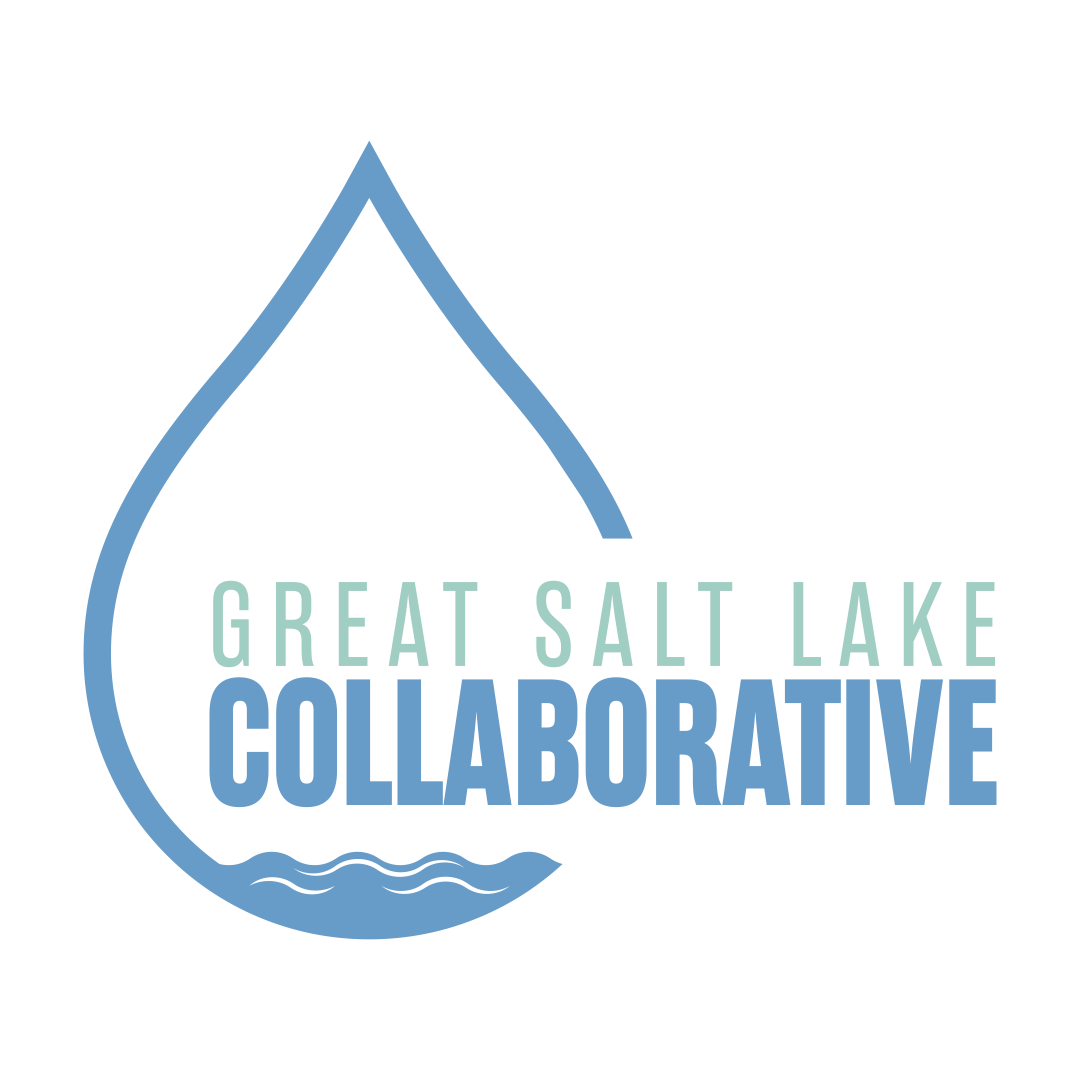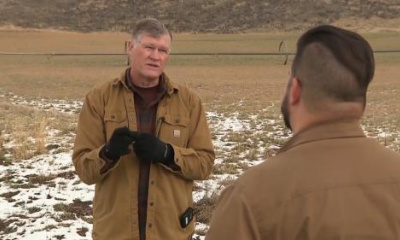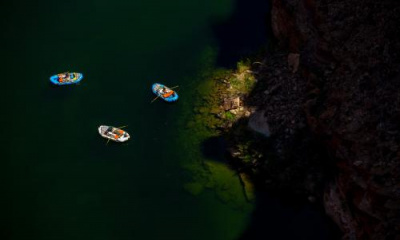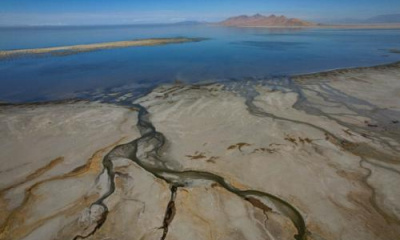Utah program pays farmers to fallow crops and it’s saving a little bit of water for the Colorado River. Whether it should be a solution for Great Salt Lake is still a thorny issue with ripple effects across Utah farming communities.
As part of its mission to elevate reporting on potential solutions for the Great Salt Lake, the Great Salt Lake Collaborative paid for Utah Public Radio and FOX 13 News to partner in reporting on fallowing from Green River, Utah. More articles like this can be found at greatsaltlakenews.org.
GREEN RIVER — It is the kind place where you might stop only briefly to pick up a sweet and juicy melon from a roadside stand along Highway 70, or for a place to sleep if all the hotels in Moab, an hour drive south, are full or too pricey. But for the Thayn family — Lee Thayn, his son and his grandchildren — Green River is paradise, a family haven for four generations of farmers. They are one of only a handful of full-time farmers in the small town, population 865.
The 3,000-acre Thayn ranch is nestled along the west side of the Green River. The 730-mile-long river is the chief tributary of the Colorado River. It begins at the headwaters of the Wind River Mountains in Wyoming and flows through Utah, making a loop through a section of Colorado before meeting the Colorado River in Canyonlands National Park.
The Green River is their lifeline. The Thayns rely on it to grow alfalfa, corn, and a sprinkling of melons in this dry desert region of eastern Utah.
“Alfalfa and corn love each other because alfalfa fixes nitrogen and corn loves nitrogen, a good rotation,” Lee Thayn said.
They sell their harvests to Utah customers, and business is good most of the time. Thayn said he has never had a job off the farm in his life. “I have farmed, that’s all I have ever done and every day I go out to play.”
The family received money from the state of Utah to stop watering one of their fields for one season. The practice, called fallowing, is an effort to reduce water consumption in the stressed Colorado River system, and perhaps, for the Great Salt Lake. Officials say it costs a lot of money for small water savings, but Utah plans to continue the program. The Thayns participated because for them it made sense both economically and environmentally. As they see it, climate change and the drought facing the Colorado River and the West means the writing is on the wall.
“You can bury your head in the sand and say it doesn’t exist but I think you are just fooling yourself. At some point we are going to have to recognize that we may have to change some practices. There are going to be some things that we have to do to be more environmentally friendly to fit the limited resource that we have, and understand that if we don’t there are going to have to be some modifications. And I would rather be at the forefront of that and do what we can than to be forced to make other considerations,” Nathan Thayn said.
The Thayns bought the farm in 1979 and want to keep farming it forever. Nathan Thayn moved back after college and never left. “I love it, I raised my kids here. ”
The Thayns are one of 64 applicants that were approved for the 2023 System Conservation Pilot Program (SCPP). It’s a voluntary one-year program administered through the Upper Colorado River Commission (UCRC) that provides a way for farmers to get paid for conserving water, usually by fallowing their fields.

This field in Green River owned by the Thayn family normally grows corn and alfalfa. But it is shown in October 2023 lying fallow as part of an experiment by the Upper Colorado River Commission to pay farmers not to grow crops to save water for the Colorado River Basin. Manuel Rodriguez, FOX 13 News.
The lifeblood of the West
The Colorado River provides nearly 40 million people across the West and a part of Mexico with drinking water, irrigates about 4.5 million acres of farmland, provides vital resources for 30 tribal nations, and supplies Western states with hydropower. It even reaches taps in Northern Utah. Some water from the Colorado River Basin is diverted into the Salt Lake area and other cities along the Wasatch Front.
A University of California, Los Angeles study shows that two decades of drought fueled by warming temperatures have sapped the river of 10 trillion gallons of water, threatening the sustainability of the communities relying on this system.
The rescue plan
The federal government stepped in and allocated $4 billion from the 2022 Inflation Reduction Act for Colorado River water conservation projects, sponsored through the U.S Bureau of Reclamation. Upper Basin states (Utah, Wyoming, Colorado and New Mexico) were given $125 million for conservation projects. The U.S. Secretary of the Interior has requested all seven states that rely on the river to reduce water consumption by a total of 2 million to 4 million acre-feet, a significant percentage of the Colorado River’s total annual flow, which has averaged approximately 12.6 million acre-feet since 2000.
In response, the Colorado River Authority of Utah, implemented the SCPP in Utah to allow agricultural, industrial and municipal water users to conserve water without losing their water rights or livelihoods. Out of 24 Utah project proposals received, 20 were accepted to take place in 2023. According to water authority staff engineer Lily Bosworth, most of the projects are agricultural and involve fallowing alfalfa fields for a season or partial season.
Fallowing saves water and unearths fears
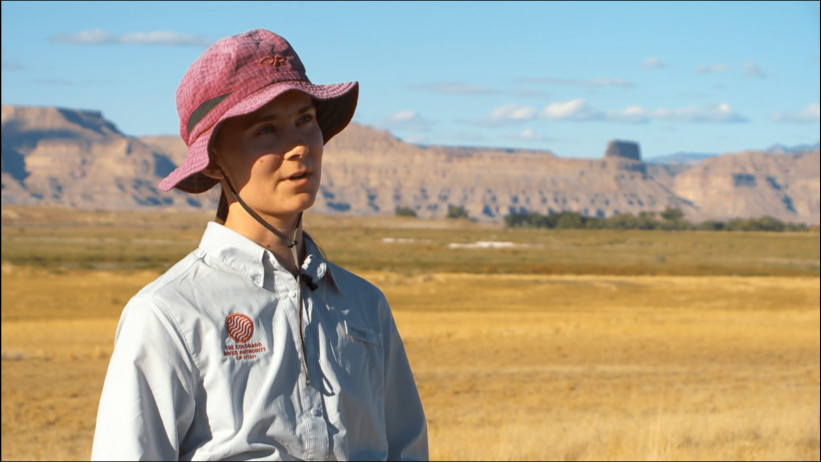
Lily Bosworth, staff engineer for the Colorado River Authority of Utah, explains a program that pays Utah farmers to temporarily fallow their fields ito save water for the Colorado River. Manuel Rodriguez, FOX 13 News.
Bosworth said “in the Colorado River Basin we're really looking at the water that escapes into the atmosphere, and that's what we're looking to conserve.” Essentially, the water being saved is the portion that would otherwise be evaporated, transpired, incorporated into crops or consumed by humans or livestock.
Participants did not have to go broke. They were compensated from $150 to $650 per acre-foot of water they saved.
For the Thayns, the program allowed them time to clean up a hay field that they are preparing for corn.
“We could kill two birds and take advantage of the time to fix it while still allowing the water to go and be used downstream,” Nathan Thayn said.
Lee Thayn said he is encouraged by the program’s economic approach. But even though losing water rights is not on the table, it’s a looming threat nonetheless as the Thayns strive to preserve their way of life at the ranch — the rural quiet, working alongside family, the horses and free-roaming friendly dogs, and even the trials of black bears feasting on their corn fields.
“It’s worrisome when these lakes, and rivers and reservoirs start getting so low that they start talking about legal [action] because that really puts you in no man’s land. It is frightening to me,” Lee Thayn said.
When asked if he would continue with this kind of program, he said agriculture is a really expensive game because water inputs are becoming prohibitive if not used carefully.
“We know that the water thing is going to get tighter and tighter and more restrictive and you’ve got to do a good job. Being in agriculture, there’s a million [products] all the time that tell you it will improve your crops, but there is no supplement for water. No matter what you do, water is the No. 1 issue.”
Lessons learned and what to do better next time
Even though Utah’s fallowing program got off to a late start for the agricultural season, the measurable data showed water savings. Bosworth said the water saved in Utah was 15,090 acre-feet at an expense of about $5.4 million, meaning the state spent an average of $360 per acre-foot of water saved. Combined, the four states conserved about 38,000 acre-feet (roughly as much water as 19,000 common households use in a year) at a cost of about $16 million. Bosworth thinks it is worth it but said that fallowing won’t be a stand-alone quick fix.
“It’s very expensive and a lot of work in terms of state employees and time in terms of participants for a relatively small volume of water. It’s still something, it’s measurable.”
She added the Colorado River Authority of Utah and Upper Colorado River Commission are still very committed to the program and conserving wherever they can.
“But in the Upper Basin, because so many of our operations are individually owned and relatively small, getting that patchwork to add up to something significant takes a lot more work.”
The Upper Colorado River Commission plans to keep trying. It approved the conservation program, including fallowing, for another year with some fine tuning based on the lessons learned this year. Bosworth said the new rules require that projects start earlier in the season and they need to make sense economically.
“This last go around, we started the program really late. So it was forcing water users to make decisions late in the season. And so determining a price that made sense, both in terms of responsible expense of taxpayer dollars, but also something that the farmers could make work was a difficult balance to strike, and so we're hoping to address that better this time around.”
Is fallowing a solution for the Great Salt Lake?
Joel Ferry, executive director of the Utah Department of Natural Resources, is a fifth-generation farmer and rancher from Box Elder County, in the Great Salt Lake watershed. He grew up in Corinne on the Bear River, where it flattens out and has created deltas and wetlands.
A lot of migratory birds utilize his ranchland that he said he manages to the benefit of both wildlife and agriculture. He said his family irrigates thousands of acres on the farm where they mainly grow alfalfa, wheat, corn and grass for the cow herd.
“It's in my blood, it's in my history, it's in my family and I want to see this lifestyle and this opportunity continue on for generations to come,” Ferry said.
When it comes fallowing he urges caution.
“I can tell you in the farming community fallowing is the “f” word. It's something that is concerning to the agricultural community and rightfully so.”
That’s in part because he said many people take it as a permanent stop to farming with long-term consequences such as dust bowls from bare fields and out-of-control weeds. Or worse, he said: the loss of a rural community and its water.
‘Not all land is equal’
“It’s not about shutting down entire systems, he said. ” [Fallowing] is about looking at marginal land.”
That’s the kind of land with a high salt content or that has poor drainage or poor topsoil that still consumes a lot of water to grow a crop, a prime candidate for fallowing.
Ferry said it is not a permanent solution but on a short-term basis it can have some very positive benefits such as getting water to the Great Salt Lake or helping a river system. The SCPP did just that for the Colorado River.
In fact, the Utah Department of Natural Resources sought up to a $100 million appropriation from the Utah Legislature last year to pay farmers to fallow certain crops. It was proposed but did not pass.
A new priority
Ferry said fallowing is not something the state is widely promoting at this time.
For the Great Salt Lake Watershed one strategy he recommends instead of fallowing is split--season leasing, where a farmer rotates crops and is compensated for the ones that don’t require irrigation, like wheat, at the beginning and end of a season.
The current panacea being touted to get more water into the Great Salt Lake is the Agricultural Water Optimization program.
Through this program farmers are compensated by the state for up to 50% of the costs for implementing an array of drought-resilient practices and technologies.
“The demand for that program is enormous, the benefits are enormous, the outcomes are incredible and it's one that's being very successful in its implementation,” Ferry said. “It creates a drought-resilient community.”


